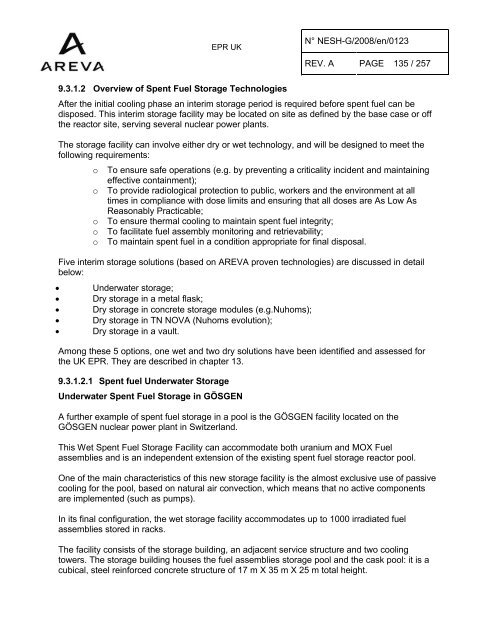Solid Radioactive Waste Strategy Report.pdf - UK EPR
Solid Radioactive Waste Strategy Report.pdf - UK EPR
Solid Radioactive Waste Strategy Report.pdf - UK EPR
You also want an ePaper? Increase the reach of your titles
YUMPU automatically turns print PDFs into web optimized ePapers that Google loves.
<strong>EPR</strong> <strong>UK</strong><br />
N° NESH-G/2008/en/0123<br />
REV. A PAGE 135 / 257<br />
9.3.1.2 Overview of Spent Fuel Storage Technologies<br />
After the initial cooling phase an interim storage period is required before spent fuel can be<br />
disposed. This interim storage facility may be located on site as defined by the base case or off<br />
the reactor site, serving several nuclear power plants.<br />
The storage facility can involve either dry or wet technology, and will be designed to meet the<br />
following requirements:<br />
o<br />
o<br />
o<br />
o<br />
o<br />
To ensure safe operations (e.g. by preventing a criticality incident and maintaining<br />
effective containment);<br />
To provide radiological protection to public, workers and the environment at all<br />
times in compliance with dose limits and ensuring that all doses are As Low As<br />
Reasonably Practicable;<br />
To ensure thermal cooling to maintain spent fuel integrity;<br />
To facilitate fuel assembly monitoring and retrievability;<br />
To maintain spent fuel in a condition appropriate for final disposal.<br />
Five interim storage solutions (based on AREVA proven technologies) are discussed in detail<br />
below:<br />
· Underwater storage;<br />
· Dry storage in a metal flask;<br />
· Dry storage in concrete storage modules (e.g.Nuhoms);<br />
· Dry storage in TN NOVA (Nuhoms evolution);<br />
· Dry storage in a vault.<br />
Among these 5 options, one wet and two dry solutions have been identified and assessed for<br />
the <strong>UK</strong> <strong>EPR</strong>. They are described in chapter 13.<br />
9.3.1.2.1 Spent fuel Underwater Storage<br />
Underwater Spent Fuel Storage in GÖSGEN<br />
A further example of spent fuel storage in a pool is the GÖSGEN facility located on the<br />
GÖSGEN nuclear power plant in Switzerland.<br />
This Wet Spent Fuel Storage Facility can accommodate both uranium and MOX Fuel<br />
assemblies and is an independent extension of the existing spent fuel storage reactor pool.<br />
One of the main characteristics of this new storage facility is the almost exclusive use of passive<br />
cooling for the pool, based on natural air convection, which means that no active components<br />
are implemented (such as pumps).<br />
In its final configuration, the wet storage facility accommodates up to 1000 irradiated fuel<br />
assemblies stored in racks.<br />
The facility consists of the storage building, an adjacent service structure and two cooling<br />
towers. The storage building houses the fuel assemblies storage pool and the cask pool: it is a<br />
cubical, steel reinforced concrete structure of 17 m X 35 m X 25 m total height.

















